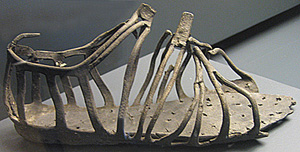 Roman sandal, 1st/2nd century CE
Roman sandal, 1st/2nd century CE
 Roman sandal, 1st/2nd century CE
Roman sandal, 1st/2nd century CE
Septimia Stratonice was a free woman plying a trade not considered women's work even today. Her funerary monument testifies that she was a shoemaker (sutrix) in the harbor town of Ostia between the 1st-2nd centuries CE. On the left side of what remains of her marble tombstone she is pictured in a niche beside her epitaph. Dressed in a simple belted ankle-length tunic and seated sideways in a low round-backed chair (see another solium in this shop relief and replica), she holds out in her right hand a shoe last, a wooden mold (forma) around which dampened leather was shaped in preparation for making a shoe. In return for her unnamed good services to him, Stratonice was given (donatione) a share by Marcus Acilius in his son's burial place and monument. Septimia's name indicates that she was a freed slave (see Roman nomenclature; from the mid-first century CE on, non-imperial freedpersons increasingly omitted their status indication). She and the dedicator bear the gens names of noble families prominent in Ostia and Rome, the imperial Septimii and the consular Acilii. Acilius refers to Stratonice as his carissima amica (see also Maria Auxesis in the World of Flirtation), a term that signifies more than a patronus-cliens relationship, but is otherwise ambiguous. Was she a close associate or a mistress? Furthermore, his generous burial of her in his family tomb is an odd gesture if she was not the boy's mother. It is ironic that the portion of the monument which may have contained Acilius' son's portrait is lost. For a discussion of concubinage, see Rawson's article in the Bibliography.
HOC SEPVLC[rum]
M[arcus] ACILIVS
SEPTIMIA[e Stra]
M[a]E OB BEN[e facta]
AB EA IN SE [dimidia]
PARTE ET [. . . Aci-]
10LIO FORT[unati-]
ANO FILIO [ . . .]
Click on the underlined words for translation aids and commentary, which will appear in a small window.